Scottish Schools Adolescent Lifestyle and Substance Use Survey (SALSUS): drug use report 2018
Findings on drug use from the 2018 wave of the Scottish Schools Adolescent Lifestyle and Substance Use Survey (SALSUS).
This document is part of a collection
5 Drugs education and support
Where pupils would go for drugs information
Pupils who had used drugs were most likely to say that they would go to either a friend or a parent if they wanted more information about drugs. 13 year olds were about as likely to go to a friend or parent for advice, while 15 year olds were more likely to go to a friend (Figure 5.1).
Among both age groups, boys were more likely than girls to say that they would go to a parent (32% of boys, compared with 26% of girls) or teacher (22% of boys, compared with 17% of girls) for help. Girls were more likely than boys to say they would not know where to get help (20% of girls, compared with 13% of boys).
Figure 5.1 Where pupils would go if they wanted more information about drugs, by age (2018)
Q. If you wanted information about drugs, who/where would you go to?
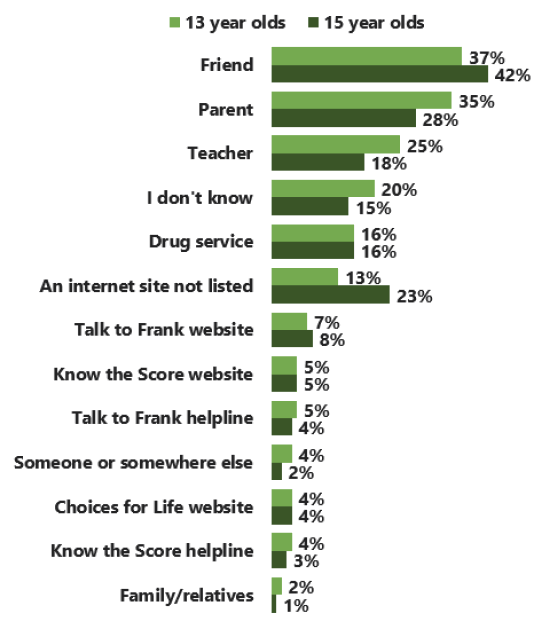
Base: 13 year olds who have ever taken drugs (644), all 15 year olds who have ever taken drugs (1,891)
Drugs education
Two thirds (66%) of pupils from each age group had received lessons, videos/DVDs or discussion in class about drugs.
There was no difference in the likelihood of having received lessons, videos/DVDs or discussions in class about drugs between those who had taken drugs in the last month and those who had not.
School advice and support
The majority of pupils thought that their school was providing them with enough advice and support about taking drugs (69% of 13 year olds and 62% of 15 year olds).
While there were no gender differences among 13 year olds, 15 year olds girls were less likely than 15 year old boys to agree that they received enough advice and support about taking drugs – 59% of 15 year old girls, compared with 65% of 15 year old boys (Figure 5.2).
Figure 5.2 Advice and support about using drugs, by age and sex (2018)
Q. To what extent do you agree or disagree with the following statement? My school provides me with enough advice and support about…? Taking drugs
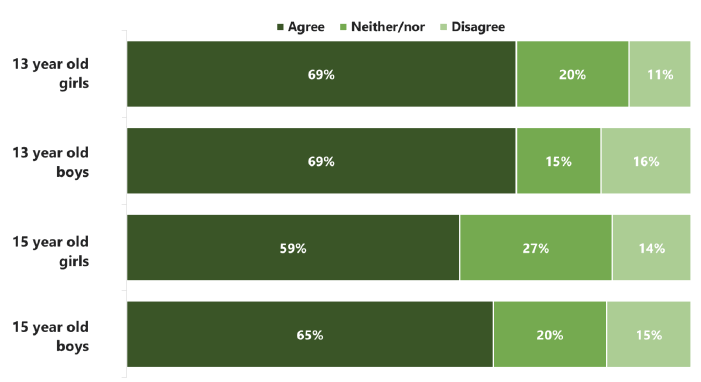
Base: all 13 year old boys (5,099), all 13 year old girls (5,261), all 15 year old boys (4,392), all 15 year olds girls (4,655)
Among both age groups, those that agreed that their school provided them with enough advice and support about taking drugs were less likely to have used drugs in the last month than those that disagreed (Figure 5.3).
Figure 5.3 Comparison of prevalence of drug use among those who agree/disagree that their school provides them with enough advice and support about taking drugs (2018)
Q. To what extent do you agree or disagree with the following statement? My school provides me with enough advice and support about…? Taking drugs
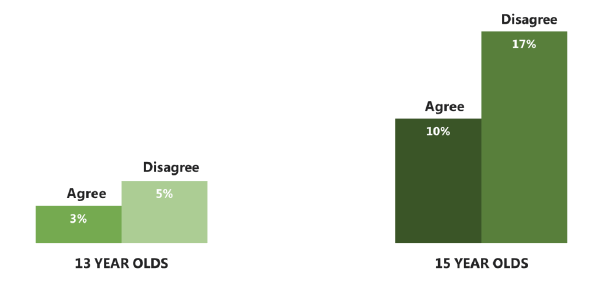
Base: all pupils who agreed/disagreed that their school provides them with enough advice and support about taking drugs (for full base sizes please see Appendix B)
Amount learned in school about drugs
Pupils were asked how much they had learned at school about a series of topics relating to drugs. At least 40% said that they had learned 'a lot' about each of the topics (Figure 5.4).
Pupils in both age groups were most likely to say that they had learned 'a lot' about the risks to their health from drugs.
Overall, boys were more likely to say that they learned a lot about each topic.
Figure 5.4 Amount learned about drugs at school, by age (2018)
Q. In school, how much have you learned about the following?
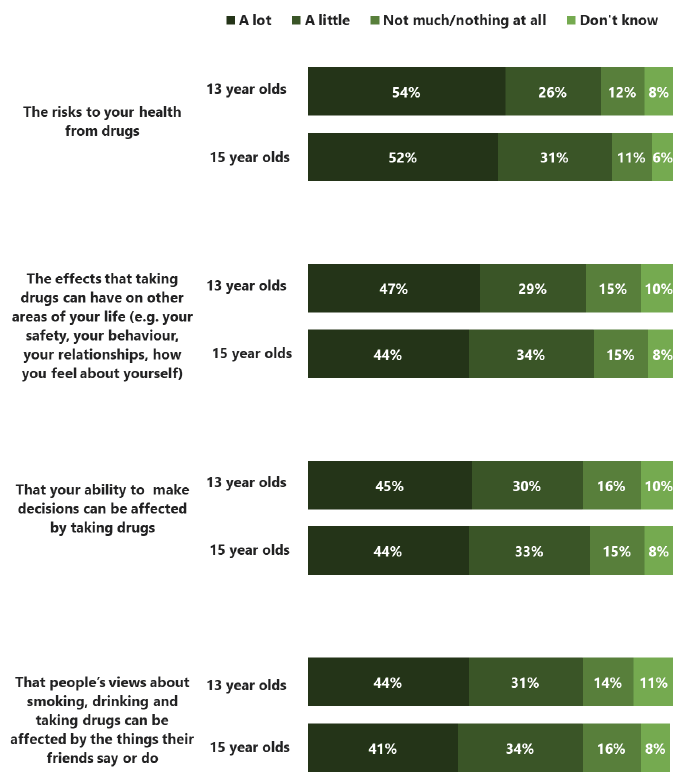
Base: all 13 year olds (10,975), all 15 year olds (9,576)
Across all four topics, those that said they had learned 'a little' or 'a lot' were less likely to have used drugs in the last month than those who learned 'not much' or 'nothing at all' (Figure 5.5). This was the case for both 13 and 15 year olds.
Figure 5.5 Comparison of prevalence of drug use among 15 year olds by how much they say they have learned about drug topics in school (2018)
Q. In school, how much have you learned about the following?
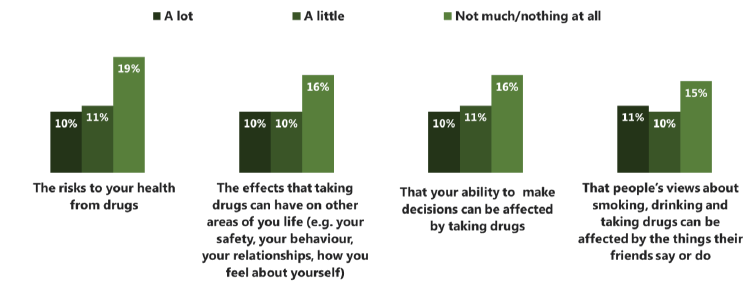
Base: 15 year olds who learned a lot about drug topics, 15 year olds who learned a little, 15 year olds who learned not much/nothing at all (for full base sizes please see Appendix B)
Confidence in health and wellbeing choices
Pupils were asked how confident they were about four aspects of health and wellbeing. Across each, the majority of pupils of both age groups reported that they felt confident in their health and wellbeing choices. 13 year olds were more likely than 15 year olds to feel confident that they had the information they needed to make the right choices about their health and wellbeing, and that they knew where to go for information and support about substance related issues (Figure 5.6).
Across both age groups, boys were more likely to say they knew where to go for information and support about substance use related issues (82% of 13 year old boys, compared with 78% of girls, and 79% of 15 year old boys, compared with 72% of girls). 15 year old boys were more likely than 15 year old girls to say they had the information they need to make the right choices about their health and wellbeing (87% of 15 year old boys, compared with 84% of girls)
Figure 5.6 Confidence in health and wellbeing choices, by age (2018)
Q. Thinking about the future, how confident do you feel about…?
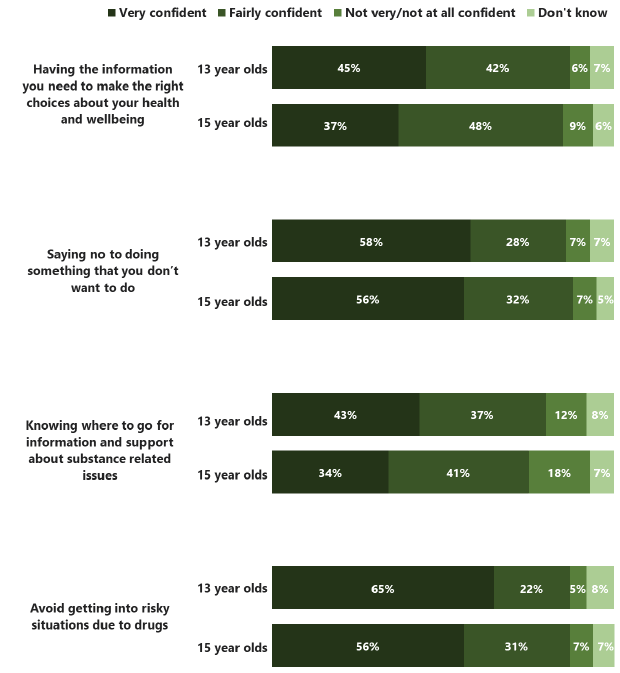
Base: all 13 year olds; all 15 year olds (for full base sizes please see Appendix B)
Feeling less confident about health and wellbeing choices was associated with drug use in the last month. Among 15 year olds, those who did not feel confident were more likely to have used drugs in the last month than those who did not (Figure 5.7). There was one exception to this: there was no difference in drug use in relation to confidence about knowing where to go for information and support about substance related issues.
Figure 5.7 Comparison of prevalence of drug use among 15 year olds, by confidence in future health and wellbeing choices (2018)
Q. Thinking about the future, how confident do you feel about…?
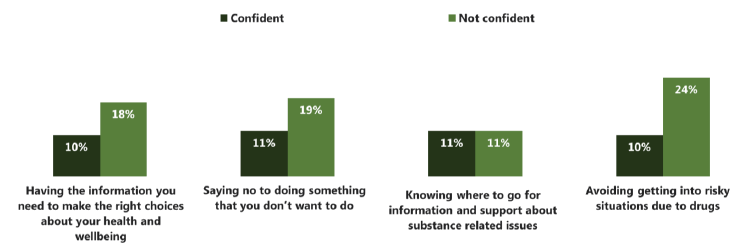
Base: 15 year olds who were confident about their future health and wellbeing choices, 15 year olds who were not confident (for full base sizes please see Appendix B)
Contact
Email: salsus@gov.scot
There is a problem
Thanks for your feedback